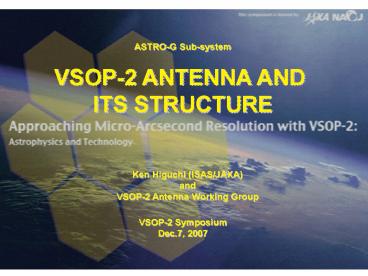ASTROG Subsystems VSOP2 ANTENNA AND ITS STRUCTURE - PowerPoint PPT Presentation
1 / 20
Title:
ASTROG Subsystems VSOP2 ANTENNA AND ITS STRUCTURE
Description:
S-band (TX, RX) VSOP-2. A Large-scale Deployable Antenna of Offset. Cassegrain Type ... Radial-rib/Hoop-cable Construction. Launching Configuration. On-orbit ... – PowerPoint PPT presentation
Number of Views:65
Avg rating:3.0/5.0
Title: ASTROG Subsystems VSOP2 ANTENNA AND ITS STRUCTURE
1
ASTRO-G Sub-system VSOP-2 ANTENNA AND ITS
STRUCTURE VSOP-2 Symposium Dec.7, 2007
Ken Higuchi (ISAS/JAXA) and VSOP-2 Antenna
Working Group
2
HALCAETS8
Heritage and Trend of Large-scale Deployable
Reflector (LDR) Technology for Mesh Antenna
VSOP-1 (HALCA) LDR (Launched 1997)
VSOP-2 (ASTRO-G) LDR (under Design)
ETS-VIII (Kiku-8) LDR (Launched 2006)
3
VSOP-1 HALCA
Center-fed Cassegrain Antenna Deployment Test on
Ground
Main Reflector about 10m tip-to-tip Diameter of
Projected Inscribing Circle 7200mm Maximum
Design Frequency for Observation 22GHz Launched
in 1997
4
Engineering Test Satellite VIII (ETS-VIII
Kiku-8)
Communication Test Satellite Connected Modular
Mesh Reflector - Good Surface Accuracy
(2.4mmRMS) - Light-weight Structure - Easy
for Ground Test and Adjustment - Easy for
Upsizing
Deployed LDR on Orbit
Outer Dimension of Reflector 19m x 17m (14
modules each) Communication Frequency S-band
(TX, RX)
5
(No Transcript)
6
VSOP-2
- A Large-scale Deployable Antenna of Offset
- Cassegrain Type
- - Maximum Observation Frequency 43GHz
- - Target Surface Accuracy of Main Reflector
0.4mmRMS - (includes thermal deformation and
vibration) - - Equivalent Diameter of Projected Area 9.56m
7
Structure and Mechanism of Main Reflector
- The main reflector is composed of seven
deployable modular antennas. - Each of the modules employs a new idea of
radial-rib/hoop-cable construction to stretch
metal mesh as a reflector surface, and to satisfy
the required surface accuracy. - Heritage of deployable truss technology for the
backside structure of ETS-VIII LDR is used for
ASTRO-G.
8
1/1-Scale Full Model
22
Radial-rib/Hoop-cable Construction
9
ASTRO-G Satellite Configuration
Launching Configuration
On-orbit Configuration
10
Geometry of Antenna Subsystem
Focus of Main Reflector
FAAM
Focus of Sub-reflector
Mechanical Axis of Main Reflector
Antenna Coordinate
Satellite Coordinate
Origin of Parabola
AAM
AAM Alignment Adjustment Mechanism FAAM Focus
and Alignment Adjustment Mechanism
11
Fundamental Specification
12
Components
13
Utility of Radial Ribs on Reflector Surface
- To suppress pillow effect of convex curved
surface - To avoid tangling of cables
- To suppress accumulation of error of connected
modules
14
Japanese Traditional Umbrella
15
Differnces between Two Modular Mesh Reflectors
Surface Cables
Hoop Cables
Tie Cables
Radial Ribs
Center Stand-Off
Peripheral Cable
Peripheral Stand-Off
Deployable Truss
Tie Cables
16
Differnces between Two Modular Mesh Reflectors
17
Deployment Sequence
Rotation of Boom-1 Hinge-1
Twist of Boom-1 Hinge-2
BOOM-1
FIXED HINGE
BOOM-2
Rotation of Boom-3 Hinge
BOOM-3
18
FAAM
AAM
19
Antenna Performance Degradation Cause
20
ENDING

